 Universal Radio is now selling the Sangean ATS-909X with a black case. Pricing is the same as the silver case ($259 US).
Universal Radio is now selling the Sangean ATS-909X with a black case. Pricing is the same as the silver case ($259 US).
For more information and reviews of the Sangean ATS-909X, please check it out in our Shortwave Radio Index (SWRI).
 Universal Radio is now selling the Sangean ATS-909X with a black case. Pricing is the same as the silver case ($259 US).
Universal Radio is now selling the Sangean ATS-909X with a black case. Pricing is the same as the silver case ($259 US).
For more information and reviews of the Sangean ATS-909X, please check it out in our Shortwave Radio Index (SWRI).
SWLing Post reader (and my good friend) Mike Kitchen writes of his new Sangean PR-D15:
Having had the Sangean PR-D15 radio for about 10 days, I’m developing a respect for it.
With what I’ve learned in its use, there is a simplicity in operation that many should enjoy.
The big feature for a radio that I really must insist on, is being able to plug this radio into 12V DC with a power supply plug. And this PR-D15 has this capability. I am using a 12 Volt DC, 12 Amp Hour battery as power supply to this radio. Digital displays and their illumination can really eat “AA”, “C” and “D” battery power, and using a 12V Gel Cell, AGM or auto battery allows many, many hours of listening.
Th Sangean PR-D15 uses a 200MM Ferrite bar internal antenna. So far, after about 25 hours of AM DXing alone (not including daily AM use), I’ve learned this radio can really hear!
In a few days, I’ll do some side by side reception tests with the PR-D15 alongside my CCrane CCRadio-SP twin-ferrite analog portable radio. And then, more side by side’s with a CCRadio-2E, the Enhanced version.
Mike, I look forward to your future radio comparison with great interest! The Sangean PR-D15 sounds like a keeper.
 SWLing Post reader, Tom, writes:
SWLing Post reader, Tom, writes:
Just thought I would tell you that at the moment I am seeing the White Sangean 909X Shortwave radio on sale from Amazon for $163.81 at the moment.
Says on the page it is 64% off which is the cheapest I have seen it so far and it ships from Amazon and not a 3rd party.
Link is http://www.amazon.com/gp/product/B003XU76PQ/ref=oh_details_o01_s00_i00?ie=UTF8&psc=1
Tom
Many thanks, Tom! I believe that is the lowest price for a 909X I’ve ever seen.
Ironically, the price of the Tecsun PL-880 has been climbing on Amazon (currently $179.99) and the PL-660 price is back to $129.99 (up $30 from November pricing).
Note that I could not advise purchasing the PL-880 from Amazon at the moment as it appears that they have a stock of older firmware version radios (see previous post).
This article, which extensively reviews–and compares–the Tecsun PL-880, PL-660, the Sangean ATS-909X, and the Sony ICF-SW7600GR, originally appeared in the June 2014 issue of The Spectrum Monitor Magazine. Without a doubt, it’s my longest and most comprehensive review to date.

Summer: time for travel–and for portable shortwave DXing. As I mentioned in the March TSM issue, I love combining travel with shortwave radio listening. But what radio should I pack?
This time of year, on the SWLing Post, I receive an increase in the number of queries asking some variation of the following, “What is the best, full-featured, portable shortwave radio on the market?” Oftentime it’s an upcoming trip, or just some time off work, that prompts the question, but without a doubt, this is the most-often-asked question from my readers. Typically, the reader has several models in mind and is curious how they compare. And since a good portable radio costs between $100 – $230 US, it’s not an impulse purchase decision for most of us.
In this month’s column, I hope to answer this question as thoroughly as possible so you can make an informed purchase decision that’s right for you. All four radios I mention in this article are what I would call “flagship portables” (generally, these are the best portables from any particular manufacturer). These were recently featured in a highly-energized reader survey on the SWLing Post, and are as follows: the Tecsun PL-660, the Tecsun PL-880, the Sony ICF-SW7600GR, and the Sangean ATS-909X.

The price tags for these radios fluctuate, but all are generally available between $100-$230 US, and are actively in production right now.
Moreover, all these radios have a similar form factor: they are portable enough to be operated handheld, sport a direct-frequency entry keypad, a dedicated external antenna jack, and a generous backlit display. All of them also have SSB, and all but one have selectable sideband synchronous detection.
With the exception of the Sangean ATS-909X–on loan from a friend for the purposes of this review–I have easily spent 40+ hours of listening time with each of these radios. I know their individual characteristics quite well and have used them in a variety of situations.
In case you’re not familiar with each of the contenders, a brief summary of each radio follows with an overview of the features that make it unique.
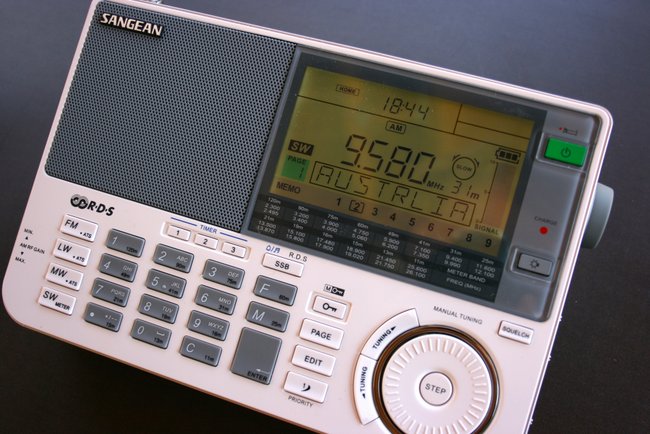
If there was an award for the best-looking radio, I think the ATS-909X would win. The 909X designers put a great deal of thought behind the design and ergonomics of the 909X; for instance, there are two indentations on the back of the radio which allow it to fit nicely in your hands. The 909X sports an internal speaker that produces excellent audio fidelity with a crisp response and even some distinct bass notes, especially notable if listening to an FM station. Of all of the radios listed here, the 909X has the the best variable receiver gain, tone control, largest display, and is the only radio with RDS (Radio Data System).

While I like the position of the tuning wheel on the front of the radio, which is ideal for tuning with your thumb and reminiscent of the ICF-SW55, I don’t like the indents you feel as you tune. If you’re a listener that takes advantage of radio memory, the ATS-909X has a very appealing feature: alpha-numeric memory tags. When you store a Radio Australia frequency to memory, your 909X can display the full station name in large, easy-to-read characters.
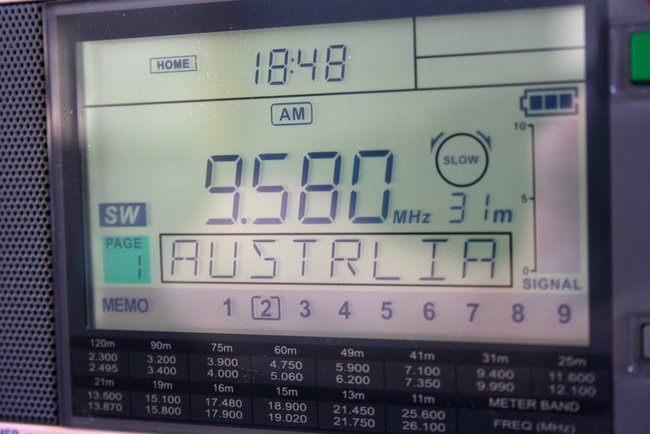
There is one omission from the 909X, though, that I find a bit surprising: it has no synchronous detection. While I don’t use a sync detector all of the time, it does come in handy when fading (QSB) and adjacent signal interference (if the sideband is selectable) are present. For a radio that costs over $210 US, on average–the priciest on this list, by a long shot–I feel like sync should have been a given.
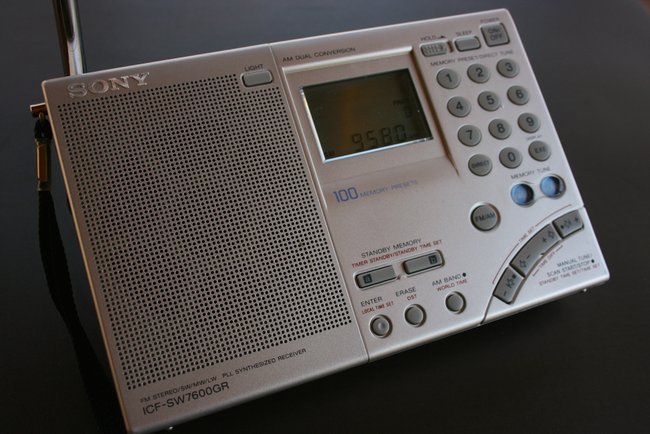
The Sony ICF-SW7600GR comes from a series of “7600” portables that date back to 1977. Though the ’7600GR has all of the modern features one would expect for a radio in its price class, it’s a bare-bones receiver in this particular crowd. It lacks the advance memory functions of the PL-880, PL-660 and, especially, the 909X. The display is smaller and more basic, although it does provide the most vital information.
I have traveled extensively with the ’7600GR, however, as it has rock-solid, reliable performance; it’s my work horse and go-to radio for field recordings because I find its AGC and sync detector remain among the best in this class of radio. It also has a dedicated, stable line-out jack. Important controls are all accessible, and I can easily engage the key lock without fear of accidentally pressing the wrong button during the recording.

My main gripe about the ’7600GR, however, is its lack of a tuning knob and overall poor ergonomics. My personal preference is to use a tuning knob for band-scanning, as pressing buttons just doesn’t give the same sense of responsiveness. For casual tuning and band-scanning, I leave the ’7600GR in its case. Nor is this radio intuitive–indeed, to learn all but the most obvious functions of the ’7600GR, you’ll need to reference the owner’s manual. Audio from the ’7600’s internal speaker is average/unremarkable.
Still, my Sony ’7600GR’s solidity makes it a friend I would never part with. The real test? If it was ever lost or broken, I would promptly repair or replace this radio.
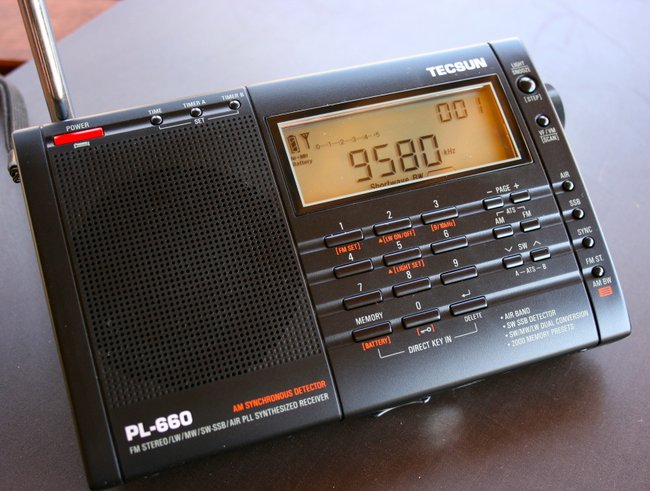
Though I’m often an early adopter of new shortwave portables, I wasn’t for the Tecsun PL-660. When it came out, I figured it would be redundant, considering the many other portables I own with synchronous detection.
Long story short: I was wrong.
Having at last acquired the Tecsun PL-660 last year, I now know it’s a pleasure to operate, and feature-rich for its price. The PL-660 is the bargain in this bunch of benchmark rigs, and significantly so: at an average price of $105 US currently, it is easily half the price of the ATS-909X.
The PL-660 is a pleasure to operate, and a true performer. Its selectable synchronous detector is one of the best in this group of portables: it’s on par with the Sony ICF-SW7600GR. It locks onto a station and rarely loses that lock. Ergonomics are excellent on the PL-660, too–the buttons have a tactile response, are well marked, and all functions are simple to find. The right side-mounted tuning knob has a smooth action.
The Tecsun PL-660 has been on the market since 2011 and has a dedicated following amongst SWLs, many of whom favor it above anything else in its class.
Of course, the PL-660 isn’t perfect, however. It lacks a line-out jack, something I find essential for recording shortwave broadcasts. The audio from the internal speaker is okay, but not on par with the ATS-909X, or its cousin, the PL-880 (below). Still, at $105 US, the PL-660 is truly a steal.
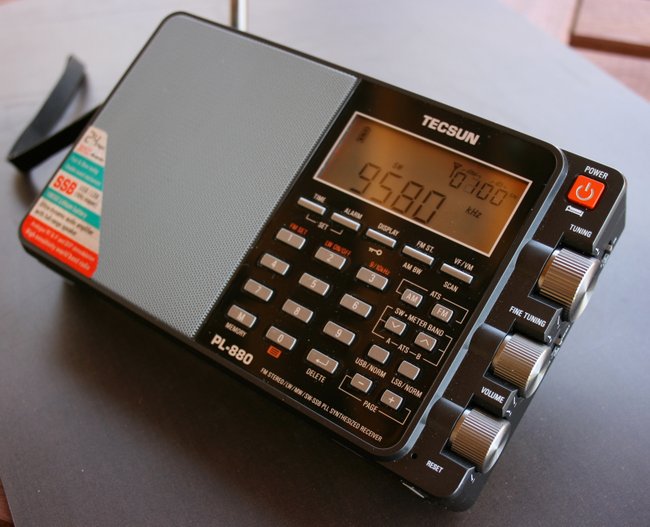
The Tecsun PL-880 only started shipping in November 2013. It was highly anticipated as the new flagship portable in the Tecsun line. The PL-880 is chock-full of features and without a doubt, is the most complicated portable I’ve ever reviewed.
The PL-880 feels like a quality piece of kit: its buttons have a highly-tactile response, the tuning/volume wheels are silky smooth, and feel well-engineered. Out of the four portables evaluated here, I find the PL-880 the most pleasurable to operate. One of my favorite features is its dedicated fine-tuning knob, just below the main tuning knob on the right side of the radio.
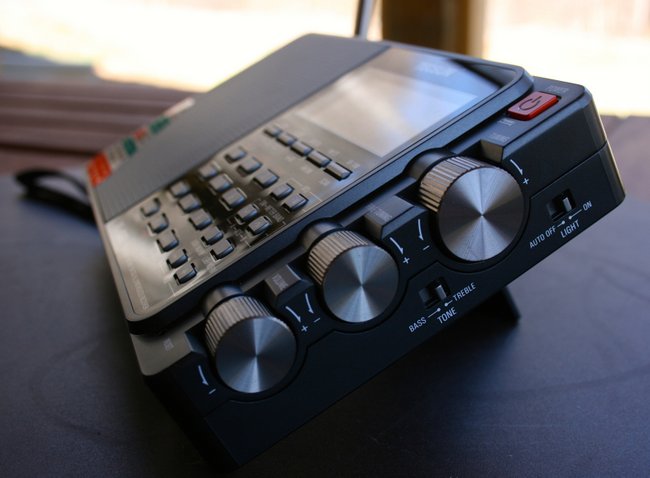
Unquestionably, the one feature which makes the PL-880 highly desirable is the amazing audio fidelity you’ll enjoy from its built-in speaker: it’s well-balanced, rich, and clear. I almost can’t emphasize this point enough–the PL-880’s speaker is capable of room-filling audio. It’s one of the few radios I’ve ever owned (other than some of my antique tube radios) that encourage listening to shortwave from across the room, with pleasing results.
The PL-880 also sports the most filter options of any other portable on the market. Indeed, in SSB mode, the filter can be narrowed all the way down to 500 hz, making this CW operator, at least, quite contented.
Cons? Yes, the PL-880 has some. First of all, I feel like its current firmware version leaves room for improvement. One of the first things I had to do after receiving my radio was adjust the muting threshold so that it wouldn’t engage. Many of the PL-880’s adjustments are mysteriously hidden, even undocumented in the manual. One such hidden feature is its synchronous detection, which is the least refined in this set of portables: it has difficulty maintaining a stable lock, thus audio is significantly compromised.
[Click here for our comprehensive (and growing) list of PL-880 hidden features.]
Changing settings often results in the radio “thinking” for a second or two, during which time it mutes the receiver. This phenomenon is most pronounced when changing modes (from AM to LSB, for example). I find it rather distracting.
Still, I do like the PL-880. Its audio and overall quality make up for any annoyances. I suspect it will have a long product life and a loyal following over the coming years.

Since I’m listening to the shortwaves 90% of the time I’m listening to a radio, I’ve limited the scope of my assessment here to the shortwave bands. With that said, none of these radios will disappoint you on AM or FM. I did note in my simple home comparison that the Sangean ATS-909X seemed to be the leader on the FM band. The Tecsuns were perhaps best on the AM (mediumwave) band.
But what about on shortwave? I like using recordings to evaluate shortwave radio performance, typically representative clips that are 25-60 seconds in length. Why? Anytime I have more than two radios to compare, it gets difficult to switch between radios, insuring that I give each one the same opportunity to receive a station. More importantly, with this method, I can listen to the audio clips on my computer, and flip between them quickly to determine characteristics I like in each.
Before recording, I set each radio in the same spot on a table, though I might change the orientation for optimal reception (since this can differ from one radio to another). I then extend the antennas fully and set all of the filters, gain controls, tone, volume levels, and frequencies to the same position on each rig. This way, my comparison can be on an “apples-to-apples” basis.
Note that I do not use an external antenna in any of these tests. This because I believe, when considering portables, they should be able to function very well off of their built-in antennas–thus taking into account situations in which employing an external antenna is not practical.
So that you have an opportunity to evaluate each radio in a “blind” test, I’ll tag each audio sample with a number, the order of which will not necessarily be consistent in each consecutive test. After the clips, I’ll reveal which is which.

When I evaluate relatively strong broadcasts I typically listen for the best audio fidelity and signal stability a radio can offer. Unless there’s an adjacent signal (and in this case, there was not), I open the filter as widely as possible.
One of the strongest stations in my part of the world is Radio Havana Cuba–not always the cleanest signal, but always at blowtorch power levels. In this sample clip, I tuned our four radios to RHC.
To be fair, propagation from this station was poor the day of recording, so you’ll hear a little fading that is not normally present. Additionally, you’ll want to listen to the full clip, as a portion of each contains RHC interviews that were recorded by telephone (thus “tinnier” sounding); you’ll also hear the typical RHC transmitter hum:
Sample #1
Sample #2
Sample #3
Sample #4
You’ll hear that all of these receivers–with the exception of Sample #3–are nearly identical. Sample #3 is less sensitive than the others, thus more prone to shallow fading and a slightly higher noise level. To my ears, Sample #4 has the best audio quality and receiver characteristics, followed by Sample 2 and Sample 1.
Now let’s reveal the radios behind the samples:

I like comparing radios while listening to weak signals and/or when conditions are less favorable. Since I often listen to weak signals (after all, so few broadcasts are actually directed to North America), it’s an important test.
I found a weak signal from Radio Romania International on 11,975 kHz. Normally, the signal would have been much stronger, but propagation was rough and QSB (fading) pronounced at times. Under these conditions, you get the opportunity to hear how the receiver’s AGC circuit handles fading and troughs, how the noise floor sounds as conditions change, and judge the overall sensitivity.
While I give priority to a receiver’s sensitivity and selectivity, there’s obviously more to evaluate here–for example, the more sensitive radio may be less pleasing to the ear.
If you like, jot down what you observe as you listen to each 50 second clip:
Sample #1
Sample #2
Sample #3
Sample #4
Obviously, the radio in Sample #4 is significantly less sensitive than the other radios–it truly struggled to hear the RRI signal under these conditions.
The other radios were able to hear RRI. Sample #3 sounded fine when there was no fading present, but in the fading troughs, there was a pronounced high-pitched noise–most likely a DSP-based noise. Sample #1 had pretty solid copy with stable AGC (automatic gain control). Sample #2 was the most sensitive of this bunch.
Now let’s reveal the radios behind the weak signal samples:
In this particular test, I was most impressed with the PL-660’s sensitivity, but given the choice, I would have chosen the Sony ICF-SW7600GR as the best overall. Why?
The Sony produced audio simply more pleasant to my ears due to the stability of the AGC.
Wondering if others would draw a similar conclusion, I posted the same clips above on my blog, the SWLing Post (http://wp.me/pn3uc-2pl). I doubted whether many readers would take the time to listen, or to vote, in this blind test. Boy, was I wrong–!
I received about seventy responses by email and in the comments section of my post. All but a very few readers ranked the clips in order of preference. The Sony was the clear favorite, with a total of 40 votes as the best of the bunch. The Tecsun PL-660 was second, with a total of 23 votes as the best. No one voted the PL-880 as best. (Click here for full results: http://wp.me/pn3uc-2qH)
What became very clear from the results and the comments, however, was that people who prefer sensitivity, prefered the PL-660. People who preferred stability, preferred the ’7600GR. In a sense, both were “best,” simply depending on the listener’s preference and/or listening requirements.

To test the SSB performance of these radios, I tuned to W1AW as they worked a pile-up from Puerto Rico. You will hear some fading. For those of you not familiar with SSB listening, you should note that W1AW sounds a little “grainy” in all of these recordings; this is simply the audio processor on W1AW’s transceiver which is set to be most audible and punch through the static.
Sample #1
Sample #2
Sample #3
Sample #4
W1AW is barely audible in Sample #1. In Sample #2, audio is well-balanced, with good audio, low noise, and a stable AGC. Sample #3 sounds more narrow (even though its filter, like all, was set to the widest setting), but the audio “pops out” of the static and is very intelligible. Sample #4 sounds much like Sample #2, perhaps slightly more sensitive but with slightly less stable AGC.
By now you may have guessed each radio behind these samples…Here’s the lowdown:
I believe the Tecsuns perform best in this category, even though the difference between the two models is pretty dramatic. The PL-880 has the best sensitivity in SSB–indeed, I could have probably lowered the gain on my recorder and made the background noise sound even less pronounced, but I wanted the levels to match the other receivers. I was somewhat surprised its 5 kHz filter sounded so narrow on SSB.
The Tecsun PL-660 had the most pleasant audio, but during QSB peaks, its audio would suffer a little distortion (you only hear this once in this sample, near the end of the recording). The Sony had slightly less sensitivity, but the most stable AGC.
Once again, the Sangean ATS-909X struggled to hear the signal, having the least sensitivity of the group.
A note about the Sangean ATS-909X
Alas, the most disappointing radio in all of these tests is the Sangean ATS-909X.
To be fair, however, it’s worth noting that the Sangean performs admirably if connected to an external antenna. Again, I resisted connecting an external antenna in this particular series of tests because I believe a good portable radio’s performance should first be judged upon what it can receive with only its telescoping whip antenna, considering that, when traveling, it’s not always possible to use an external antenna.
Indeed, if you plan to buy a portable that will be hooked up to an external antenna more often than not, the Sangean ATS-909X may be a good choice for you. Its front end can handle external antennas better than most of the radios above (with the Sony as an exception, in my experience).
Syncronous detection
I did not test sync detection, as the Sangean ATS-909X lacks a sync detector and the Tecsun PL-880’s sync detector leaves much to be desired. But many hours of listening to the Sony ’7600GR and the Tecsun PL-660 leads me to conclude that their sync detectors are fairly comparable in performance.
Although all of these receivers are considered best in the portable realm for a particular manufacturer, each has a character that suits individual listening skills or requirements.
Herein lies the difficulty offering advice on which portable to purchase. Because radio listening tends to be a solitary hobby, it comes down to personal preference–like choosing a friend. What one person values may matter very little to someone else.
For example, I rarely (if ever) save stations to memory on a permanent basis. Other than temporary auto-tuning memory features, I never give memory functions any weight when making a purchase decision (for myself, that is). Yet there are listeners who place a great deal of emphasis on memory functions.
To be perfectly honest, I think each one of these radios has an individual character that makes it a stand out for a particular type of listening. While I often sort through my collection to give away radios that I seldom use, you won’t find me letting go of any of these rigs. The Sony ICF-SW7600GR is still my favorite portable for field recordings; its stable nature and robust front end mean that I can hook up long wire antennas if I wish. The PL-880 is the radio I reach for if want robust sound and armchair listening to shortwave and mediumwave–I also find it the best of the bunch to tune, a quality machine harkening back to the glory days of Panasonic and Sony. The PL-660 is my simple, bullet-proof performer–when in doubt of conditions, it’s the radio I reach for. If I owned the Sangean ATS-909X, it would probably become my bedside shortwave; its audio fidelity, large display, stable back stand, and ability to benefit from an external antenna make it very appealing for this purpose.
You can’t go wrong with any of these benchmark performers, so long as you know its weaknesses and strengths–which I hope this review has made clear.

I’m forcing myself answer this question. While it’s difficult to answer, I believe if I could only have one of these radios for travel…I would chose the Tecsun PL-660. I find it the best overall performer, and a true bargain at its price point.
To be clear, if the Sony ICF-SW7600GR only had a tuning knob, it would be my choice, instead. If the Tecsun PL-880 handled weak broadcast signals better, it might be my choice.
But this is my personal choice; you might have a completely different answer. I guess that’s the point I made earlier–it all depends on the listener.
Now…which do you choose?
Jeff over at the excellent Herculodg blog, is about to pull the trigger on this Sangean WR-15. I must admit, I’m mighty tempted, too–about as tempted as I get for radios lacking shortwave coverage.
I love the simple design, the analog dial, and the three choices of finish: walnut, black leatherette, and silver piano finish.
At $145.95, the WR-15 is no bargain basement find, but I’m willing to bet it’ll perform quite well. Perhaps as well as my Tivoli Model One? We’ll see.
I’m sure Jeff will post a review on the Herculodge after he receives his unit in the coming weeks/months! Thanks for the tip, Jeff!
 Jeff, over at the Herculodge, writes with some disappointing news:
Jeff, over at the Herculodge, writes with some disappointing news:
What a shame John bought the WR-15 and thinks it stinks: http://herculodge.typepad.com/herculodge/2015/04/john-cannot-recommend-the-sangean-wr-15-radio-due-to-subpar-am-and-fm.html
Oh, that is a shame. An AM/FM radio with poor AM/FM sensitivity has little appeal (even if it has a great chassis).
John (the reviewer) mentions what sounds like a squelching effect during tuning as well–when a strong signal is received, volume increases with the “lock.” Perhaps a sign this Sangean receiver is powered by a DSP chip and isn’t analog at all?
I expected something better from Sangean. At least the WR-15 is one thing I can safely pull off of my Amazon wish list!
 After the Sangean WR-15 received low marks for AM reception in an Amazon review, Bob of Sangean America replied that poor reception is due to the radio’s switching power supply–a design that is federally mandated.
After the Sangean WR-15 received low marks for AM reception in an Amazon review, Bob of Sangean America replied that poor reception is due to the radio’s switching power supply–a design that is federally mandated.
Many thanks to Jeff over at the Herculodge for posting this (click here to read the full response).
It’s a shame the WR-15 can’t accommodate internal batteries as battery operation this would solve the problem.
If I owned the WR-15, I would simply replace the switching type power supply with a regulated power supply.
Looking at the back of the WR-15 (below), it appears it requires 12 volts DC, 1.2 amps and an adapter with a positive center tip. Though I’m judging this only from the image, the plug looks to be a common size. I bet I have a power supply that would fit the bill in my junk drawer.
I bet I have a power supply that would fit the bill in my junk drawer.
Bob, at Sangean America, claims moving the radio at least one foot from the power supply should help. In truth, I believe much of the noise may be conveyed by the power cord itself, though I may be wrong.
It’s a shame Sangean engineers couldn’t compensate somehow for the noisy power supply as it seems this radio was actually marketed to AM radio enthusiasts.

Many thanks to SWLing Post contributor, Aaron Hyde, who reports that Sangean has a new travel radio on the market: the Sangean ATS-405.
Aaron writes:
“While looking around the internet today, I came across a new DSP shortwave radio called the Sangean ATS 405. The 405 looks a lot like its 404 predecessor except that it includes 3 bandwidths, 148 memories, a squelch control and comes along with some other interesting features.”
The ATS-405 came as very much a (welcome) surprise to me as Sangean hasn’t introduced a new shortwave radio in years. This radio is obviously based on a DSP chip and has three selectable bandwidths–I hope its AGC circuit is well suited for weak DX. I am a little disappointed the ATS-405 doesn’t have a tuning wheel. Still, I hope this will be a winner.
The ATS-405 owner’s manual (download here) lists the following features:
I will plan to purchase an ATS-405 in the near future and review it in due time. Please comment with your impressions if you’ve purchased one!
The Sangean ATS-405 is available from the following sellers from $89.00 to 95.00 US:
Many thanks agin, Aaron, for the tip!
Many thanks to SWLing Post reader, Chris Freitas, who has informed me about a review he just published of the Sangean WR-22 AM/FM clock radio.
 This week, both Jay Allen and Chris Freitas have reviewed the Tecsun PL-680. If you’re considering purchasing a PL-680, you should check out both reviews and also our PL-680 review and radio comparison from February.
This week, both Jay Allen and Chris Freitas have reviewed the Tecsun PL-680. If you’re considering purchasing a PL-680, you should check out both reviews and also our PL-680 review and radio comparison from February.
Jay has also reviewed the Sangean ATS-405 on his website and Keith Perron tells me he will include a review of the ATS-405 on today’s episode of Media Network Plus. Keith has informed me he was very disappointed with the ATS-405, but Jay’s review is mostly positive, focusing on its great AM (medium wave) performance and new tuning/muting functions.
This is certainly the week for reviews!
On that note, Universal Radio is kindly sending me a loaner Sangean ATS-405 for review. I hope to compare it with some other benchmark portables in the next few weeks. Follow the tag ATS-405 for updates.
Click on the following links to check pricing for both the PL-680 and ATS-405:
Tecsun PL-680
Sangean ATS-405
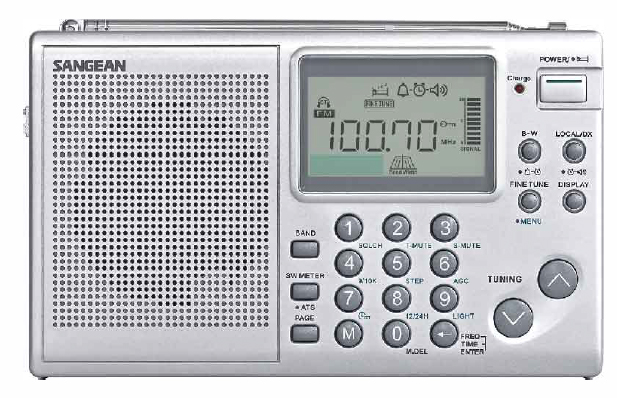 SWLing Post reader, Mike, writes:
SWLing Post reader, Mike, writes:
Keith Perron’s review of the new Sangean ATS-405 appeared in the last show of Media Network Plus. There is an archive of the show on the PCJ website for you to listen:
http://www.pcjmedia.com/medianetworkplus
The review’s at the beginning of the episode and Keith had multiple complaints about performance, build quality and the radio’s overall engineering. I don’t remember him having anything positive to say about it. Sad because I had hoped this new Sangean would be better.
Thanks for the link, Mike. For what it’s worth Jay Allen was actually mostly impressed with the ATS-405.
I’ll receive an ATS-405 later this week; and I’m very interested to see how it compares to other portables like the Tecsun PL-310ET, CC Skywave, and Tecsun PL-660. I’ll certainly report on what I find.
Here’s the audio from the Media Network Plus review:
 SWLing Post reader, Thomas Ally, writes:
SWLing Post reader, Thomas Ally, writes:
Here is Tom Stiles’ Playlist for the review of that new ATS-405
https://www.youtube.com/playlist?list=PLtQGZBHtrIF9_wPKo3Z0TqgCBqcHFydep
Many thanks for sharing this, Thomas!
 Many thanks to Jeff, over at the Herculodge for sharing information about the new Sangean PR-D19 AM/FM radio which is now available at Universal Radio and Amazon.
Many thanks to Jeff, over at the Herculodge for sharing information about the new Sangean PR-D19 AM/FM radio which is now available at Universal Radio and Amazon.
Just last week, I received the new Sangean ATS-405 on loan from Universal Radio. Though I’ve only had the radio for a week, I thought I’d share a few un-boxing photos (by request) and my initial impressions/review of this radio.
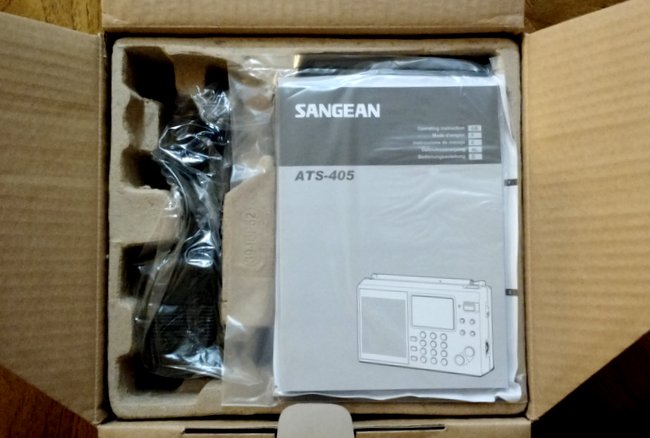 The ATS-405 comes with a thick owner’s manual (in five languages), a 7.5 volt AC adapter, and a soft radio case. The package does not contain rechargeable batteries nor a clip-on wire antenna (like many Tecsun products do, for example).
The ATS-405 comes with a thick owner’s manual (in five languages), a 7.5 volt AC adapter, and a soft radio case. The package does not contain rechargeable batteries nor a clip-on wire antenna (like many Tecsun products do, for example).
Overall, the packaging accommodates the radio and accessories efficiently and would probably ship safely even if the carrier doesn’t handle it with particular care.
 The first thing I noticed about the ATS-405 is the near-identical design and layout Sangean has used in their design of past shortwave radios. If you’re a Sangean fan, you’ll find all of the functions, buttons, and labels pretty much in the same place; virtually no learning curve.
The first thing I noticed about the ATS-405 is the near-identical design and layout Sangean has used in their design of past shortwave radios. If you’re a Sangean fan, you’ll find all of the functions, buttons, and labels pretty much in the same place; virtually no learning curve.
After unboxing the ATS-405, I installed a fresh set of AA batteries in it and turned on the radio…
Like most Sangeans, the display is crisp, clear and can easily be read straight-on or at low angles, like when the radio is resting on its back stand, for example. If you look at the display from a higher angle, however, you’ll find that the LCD digits nearly disappear.
Back-lighting is perfect: it’s soft and consistent across the display, very much like the ATS-909X.
Audio from the internal speaker is good. It’s in the same league with most similarly-priced competitors.
Keeping in mind that I’ve only logged a few days of listening time on the ATS-405, I do have some initial impressions about receiver performance across the bands:
FM
On a positive note, I believe FM performance is quite good. Perhaps not in the same league with my PL-660 or PL-680, but still the Sangean offers above-average sensitivity. I was able to pick up my distant benchmark FM stations with ease, though to help with the signal lock, I had to switch from stereo to mono reception.
AM/Mediumwave
AM reception is a bit of a mixed bag. I find that the ‘405’s overall sensitivity and selectivity are quite good for broadcast band listening.
When I first tuned around on the AM broadcast band, however, I found the noise floor a little too high. Regardless of whether I was tuned in to a station or not, there was an ever-present high-pitched hiss, like static. It was quite disappointing, especially since I read a review by Jay Allen that really complimented the AM performance on the ATS-405.
I trust Jay’s reviews, however, so I promptly contacted him. Jay pointed out that the problem may be that I was listening in the default “wide” filter setting on AM. And indeed, he was right–though I had changed filter settings a few times while tuned to local stations, I had moved it back to wide and didn’t make note of this. (The ATS-405, by the way, has three filter settings: wide, medium and narrow.)
But the wide setting is really too wide, and was certainly the source for the bulk of the high-pitched hiss I heard. The best filter setting for most broadcast band listening is the middle position, which sounds like a 5-6 kHz filter. In the middle position, noise is decreased significantly. I also believe selecting the “music” audio tone setting helps dissipate some of the noise.
Regarding the noise floor: to be clear, I still feel like the noise level is slightly more noticeable, to my ear, on the ATS-405 than on the PL-660, PL-600, and PL-310ET when band-scanning or weak signal listening. This is most likely some internally-generated noise that somehow still meets Sangean’s engineering spec.
Local AM stations sound fantastic, and the ATS-405 can detect all of my benchmarks. AM audio fidelity is better than that of my PL-660 and, even, PL-310ET. When locked on a local station, the noise floor also seems to disappear. For some reason, I even find that the ATS-405 does a better job receiving local AM stations from indoors–even near noisy electronics–than other sub-$100 portables with which I’m familiar.
Uh-oh, birdies
The most disappointing discovery I made on the Sangean’s AM broadcast band is that it has DSP birdies. Birdies are internally-generated noises resulting from the outputs of the oscillators that form part of the DSP receiver circuit. While almost all receivers do have birdies somewhere in the receiver’s reception range, radio engineers try to keep them out of the way of the important parts of the band.
Unfortunately, my ATS-405 has strong DSP birdies on 800 and 1600 kHz. This is a big negative for me, since my favorite regional AM broadcast station is located on 1600 kHz (WTZQ). Rather than attempting to describe what the birdies sound like, here are a few audio clips that will give you an idea–I start with 1350 AM, which has no birdies and is representative of good AM reception:
WZGM 1350 kHz (broadcast sample with no birdie):
800 kHz (birdie on frequency with no broadcast signal):
WTZQ 1600 kHz (birdie on broadcast signal):
The ATS-405’s birdies almost sound like a jamming signal on 1600 kHz. Indeed, if this station were only located on a different frequency, I’m sure it would be quite audible on this radio…too bad.
Birdies on 800 and 1600 kHz may very well be deal-breakers for many of us. Again, since one of my favorite regional independent broadcasters is on 1600 kHz, it’s a deal-breaker for me.
Jay specifically mentioned a lack of birdies on the AM broadcast band in his review. It could very well be that he doesn’t hear them on his particular receiver–variations in quality control on a radio production line are certainly a real phenomena (the Grundig G3 is a case in point). This could indicate that some units may have pronounced birdies while others don’t. If you purchase an ATS-405, I would check to see if your unit has birdies after powering it up.
When I contacted an engineer for Sangean North America, and described my listening experience, he confirmed that he believed these are, indeed, DSP birdies. I may ask Sangean if they can send another ATS-405 for comparison.
On a more positive note, I checked harmonics in the HF/shortwave bands and heard no DSP birdies there.
Country of origin?
One additional question I posed to Sangean: where is the ATS-405 made? One reader told me the radios are produced in both Taiwan and China. Thinking variations in quality control may be accounted for by two different production lines, I checked my radio to see where it was made. Unfortunately, my unit has no mention of country of origin; not on the radio, the box, the manual, behind the battery cover, nor on the back stand. It’s possible it could be marked internally, but I didn’t want to take apart a receiver I’ve been loaned.
Sangean came back with a firm answer:
“I can confirm that the ATS-405, along with all our radios, are manufactured in China. We have an office in Taipei for engineering, sales, marketing and customer support.”
Not a big surprise here; I expected China was the country of origin.
To sum up AM performance: if you aren’t bothered by the birdies on 800 and 1600 kHz, or if your unit isn’t producing them, you’ll find the ATS-405 a capable little AM broadcast band receiver.
Our HF propagation conditions since last Friday (when I first turned on the ATS-405) have been poor. Other than a few short band openings, I’ve struggled to hear anything other than the normal blow-torch broadcasters we hear in North America. Still, bad propagation conditions are actually good for reviewing some aspects of a shortwave receiver, so I used the opportunity.
In terms of sensitivity on the shortwave bands, I think the ATS-405 is mediocre. It lags behind my Tecsun PL-660, PL-600, PL-310ET, and CC Skywave. Adding a clip-on wire antenna to the telescoping whip (there is no aux antenna port) does help in terms of sensitivity.
Since I do most of my listening on the shortwave bands, this, too, is a deal-breaker for me. If you primarily listen to stronger shortwave stations, or spend most of your time on the FM/AM bands, then you might still consider the ATS-405.
The ATS-405’s selectivity seems to be on par with my other DSP-based portables. In truth, though, band conditions have been so unfavorable, I don’t feel like I’ve had ample opportunity to test selectivity. I’ll likely follow up this initial review with an update.
And as on medium wave, the noise floor on the shortwave bands seems a little high to me–especially with the filter set to the “wide” position.
While I clearly haven’t been wowed by the ATS-405’s shortwave performance, I have been more favorably impressed with some of its innovative features: specifically, the ability to control squelch, tuning mute, and soft mute.
 Using the menu button (see image above), you can engage or disengage the tuning mute and soft mute by pressing the “2” or “3” buttons on the keypad, then using the tuning up/down buttons to toggle these features on and off. Squelch works the same way, using the “1” button and volume control to set the threshold.
Using the menu button (see image above), you can engage or disengage the tuning mute and soft mute by pressing the “2” or “3” buttons on the keypad, then using the tuning up/down buttons to toggle these features on and off. Squelch works the same way, using the “1” button and volume control to set the threshold.
This menu control works regardless whether the radio is turned on or off.
Of course, by using the menu button and the keypad, you can also control the ‘405’s tuning steps, AGC, clock, and backlighting functionality; each of these are marked in green next to the appropriate button on the keypad (see image above), a very useful feature.
I wish other radio manufacturers would give users the ability to control some of the DSP chip’s built-in functionality, as the ‘405 does with the muting–especially since over-active soft muting has been the downfall of several DSP-based radios. Thanks for trail-blazing, Sangean!
Invariably, all radios have strengths and weaknesses; here is a list of my notes from the moment I put the ATS-405 on the air:
Pros:
Cons:
I’m going to hold onto the Sangean ATS-405 for a few more weeks, as I’d like to give it a more thorough test on the shortwave bands. I hope to follow up with a post offering a few representative recordings.
My nutshell opinion of the ATS-405 so far is that it’s a decent little radio with a lot of functionality and features for a rig in its price class. But overall, its performance seems to me rather mediocre. If you primarily listen to FM, you’ll be pleased. If you’re a mediumwave listener, you’ll be pleased only if you don’t mind the 800/1600 kHz DSP birdies. If you’re primarily a shortwave listener, you’ll need to carry a clip-on wire antenna to bring the sensitivity up to the level of similarly-priced receivers.
In short, I do want to like this radio unreservedly. But it appears that Sangean may need to pull up its socks on their quality control. Readers: please comment if you’ve purchased the ATS-405–I’m very curious to learn whether there are QC discrepancies in performance from one unit to the next.
Follow the tag ATS-405 for updates.
Many thanks to Universal Radio for supplying this radio, on loan, for review!
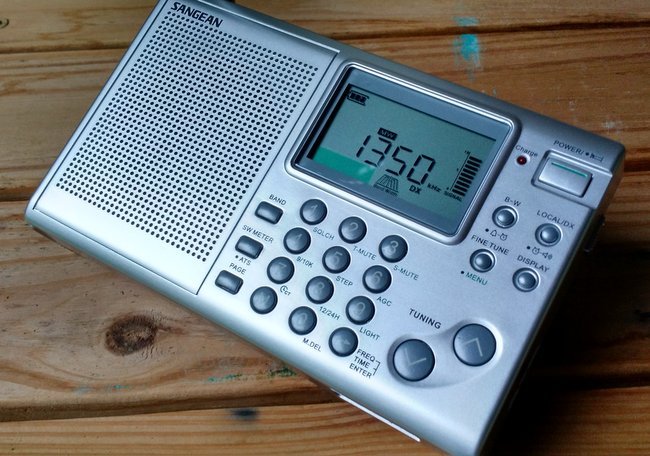 After publishing my initial review of the Sangean ATS-405, I received feedback from several ATS-405 owners (via comments and email–thank you!) who do not have the internally-generated DSP “birdies” that plague my receiver on 800 and 1600 kHz AM. I strongly suspect my ATS-405 has a manufacturing defect of some sort.
After publishing my initial review of the Sangean ATS-405, I received feedback from several ATS-405 owners (via comments and email–thank you!) who do not have the internally-generated DSP “birdies” that plague my receiver on 800 and 1600 kHz AM. I strongly suspect my ATS-405 has a manufacturing defect of some sort.
Sangean is kindly sending me another ATS-405 review sample for comparison purposes. I will post an update to the initial review as soon as I’ve had the opportunity to evaluate the new sample.
 After publishing my initial review of the Sangean ATS-405 on July 25, I contacted Sangean and requested a sample radio for comparison purposes. Back story: there were some receiver performance issues that I suspected may have been tied to my particular ATS-405 unit. Sangean kindly dispatched another ATS-405 which I received last week. The following is an update to my initial ATS-405 review.
After publishing my initial review of the Sangean ATS-405 on July 25, I contacted Sangean and requested a sample radio for comparison purposes. Back story: there were some receiver performance issues that I suspected may have been tied to my particular ATS-405 unit. Sangean kindly dispatched another ATS-405 which I received last week. The following is an update to my initial ATS-405 review.
In truth, there were two main reasons I wanted another unit to compare to my initial review radio:
I noted in my initial review that the initial ATS-405 had an ever-present noise, a sort of low-volume static hiss. The noise floor, while not high, certainly seemed to be higher than other comparable shortwave portables, and was most noticeable when tuned to marginal/weak stations. I suspect many listeners may not notice it unless they compare it with other portables.
Fortunately, my new review unit’s noise floor seems to be slightly lower than that of my initial review unit. [Perhaps this unit’s board is better soldered–?] The noise is still there, but can be better mitigated by judiciously using narrow filters and the three-position audio tone control.
I suspect this is a noise somewhere in the audio amplification chain, because I find it less noticeable with headphones, and more pronounced via the ATS-405’s internal speaker.
In terms of sensitivity and selectivity on the shortwave bands, I believe my new unit is identical to that of the initial review unit. That is to say, the ATS-405 is not an especially sensitive shortwave receiver, but fairly average, and thus will fit the bill for most but not for the discriminating weak-signal hunter. Frankly, even my $46 Tecsun PL-310ET does a better job of pulling in weak stations.
I’ve tried tinkering with the AGC settings and soft mute–very cool features!–in an attempt to improve sensitivity, but alas, these only help the quality and stability of the received signal.
Immediately after opening the box of the new ATS-405 sample, I popped in a fresh set of AA batteries and tuned the Sangean to 1600 kHz AM. [If you read my initial review, I noted a strong DSP birdie on 1600 and (to a lesser degree) on 800 kHz].
At first listen, I was happy to note that the new unit lacks the wild DSP noise that overwhelmed my favorite local station on 1600 kHz.
As I listened more carefully, though, I did note a metronomic “chick” sound that was also present but partially buried in the noise on my initial ATS-405.
Below, I’ve embedded audio comparing the two receivers:
Initial review unit:
New review unit:
Listening to these samples, I realize I may have had the filter set to the middle position on the first sample and the wide setting on the second (hence, the brighter tone).
To further demonstrate the difference between the two, I made this short video; I start with my initial review unit, then switch to the new review unit provided by Sangean:
Note that this was recorded at least 100 feet from my house on the tailgate of my pickup truck. DSP birdies on 800 kHz sounded very much like the 1600 kHz sample, save the noise level on the latter is slightly lower and there are no broadcast stations in the background.
None of my other portables have digital noises or birdies on 800 and 1600 kHz.
So, the bad news: I do still hear a noticeable (and slightly annoying) internally-generated noise on the new review unit. The good news: it isn’t as objectionable as that on my initial review unit.
In short: I stand by my initial review of the Sangean ATS-405.
While the new ‘405 review sample seems to perform better than the initial ‘405 sample, I find the discrepancy somewhat marginal, especially since I spend the bulk of my time on the shortwave and mediumwave bands.
I’m not a fan of production runs where units vary so greatly from one to another, making accurate testing difficult. Therefore it’s quite possible you might receive a unit that performs better than those I tested…but unfortunately, the opposite is also true.
So, if you’re a Sangean fan, if you don’t mind the birdies on mediumwave, and if you mostly listen to strong shortwave stations, you may entertain purchasing an ATS-405. The keypad layout is almost identical to previous Sangean models.
To be clear, of course, this radio’s negatives above have been viewed under a microscope; the ATS-405 is not a “bad” receiver, it’s just not that exceptional. Other than the added mute/AGC/squelch features, when compared to its predecessors, it’s really not a better iteration.
In conclusion? For the $90 US price, I believe there are better receivers out there–such as the Tecsun PL-600 (which, as a bonus, has USB/LSB reception–and saves you $10, to boot).
Many thanks to SWLing Post contributor, Ron, has learned about the new Sangean PR-D19 AM/FM stereo radio via Jay Allen’s website. Jay is in the process of evaluating this radio.
It appears Amazon is selling the PR-D19 in two colors: Grey/Black (currently $66.08) and White/Blue (currently $66.88).
Many thanks to Jeff, over at the Herculodge, who writes:
“Jay Allen reviewed Sangean PR-D19. He likes it a lot.”
SWLing Post reader, Marty (W5MRM), comments:
I recently picked up a Sangean ATS-909X to use as a bedside radio.
This blog post inspired me to put together a video review of the ATS-909X as a bedside radio. The video review can be found on my youtube page [or via the embedded player below]:
Great video, Marty, and thanks for the thorough review!
You can follow all of Marty’s videos on YouTube by visiting this page.